Did you know that YouTube is the 2nd largest social media channel in the world (after Facebook) so rather than just dumping your videos on there and forgetting about it, you should be taking advantage of its huge active user base together with its prominence in a search context - not just on YouTube itself but in Google search too.
What is a YouTube audit?
A YouTube audit is designed to give you an objective in-depth overview of the performance of your YouTube channel and videos. This is a great place to start for people who want to leverage YouTube but … don’t know where to start.
Performing a YouTube audit will give you clear action points and help you focus on fixing any glaring issues while baselining your performance.
A baseline is really about drawing a line in the sand. Once you have a baseline you’ll have a good idea of how many views are average per video, you’ll know average engagements, view lengths and other key stats.
Why audit your YouTube Channel?
A YouTube audit would most likely precede a YouTube strategy. This is especially important if you’re working with a client or stakeholder and need data to inform your strategy.
Without data, your strategy is based on intuition and opinion - which is fine but leaves you open to disagreement with other stakeholders. By basing your strategy on data insights, you’ll have a strong objective foundation that backs up your strategy.
It’s common for agencies or brand managers to audit their YouTube channels annually or half-yearly. Agencies can use the audit to track progress of KPIs and communicate to their client about how successful their strategy has been.
YouTube audits are also a great idea for finding things to fix or optimize. Especially if several people access your YouTube Studio account, it can be hard to determine who’s in charge of what and if anything has fallen through the cracks. An audit can reset everything and paint an accurate picture of where performance currently stands and what elements need urgent attention (for example: missing Tags on videos, non-optimized video descriptions or inconsistent use of video HashTags).
What does a YouTube Audit contain?
The two components of a YouTube Audit are:
1. YouTube Channel Audit
This involves systematically going through all the Channel details in YouTube Studio and analyzing each of these sections:
Channel layout, spotlight videos and featured sections: these options enable you to set up your channel visually based on the videos and playlists you currently have. Your current channel layout might not be the most optimal if it hasn’t been assessed for many months.
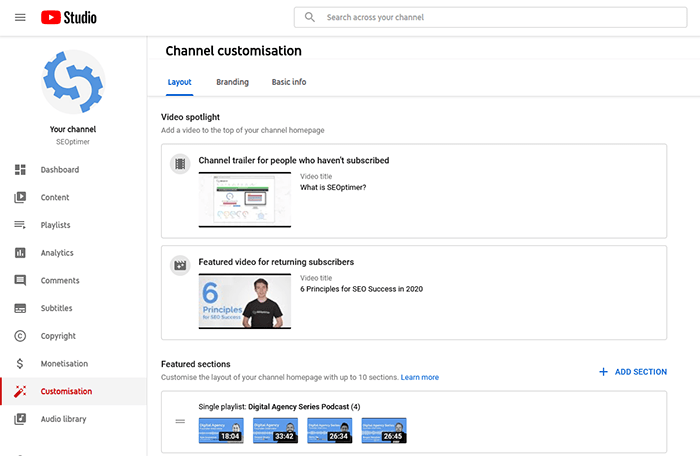
Branding: customizing your profile picture, banner image and watermark will ensure your brand displays consistently across your channel and videos:
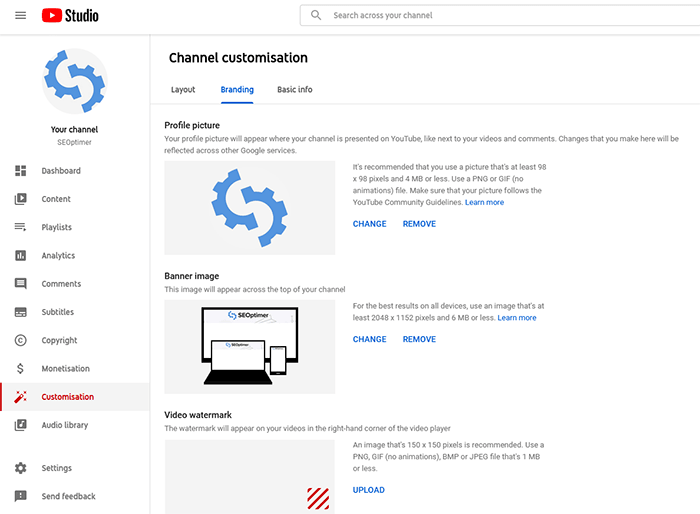
Basic info: this section let’s you customize the channel name, description, banner links and contact email address:
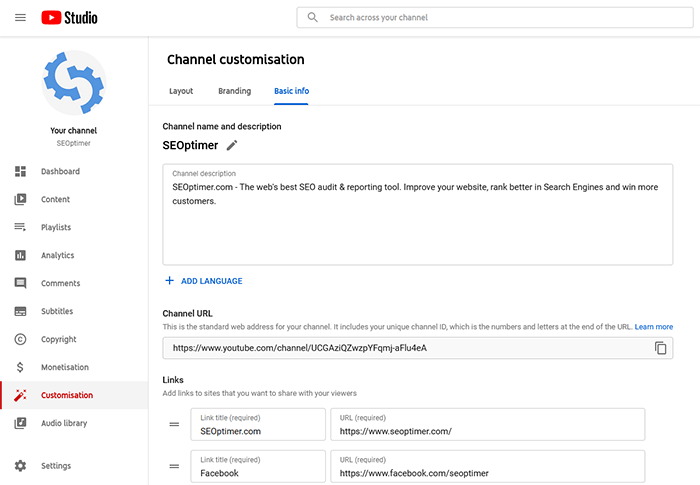
YouTube let's you link to all your other social media channels and also let's you add non-social links like your website, blog or other pages. These channel links are prominent at the top of your YouTube channel so use them to help drive traffic to your other online destinations.
2. YouTube Video Audit
The next obvious task is to audit your actual videos. Thankfully, YouTube’s Analytics tab shows great insights at an aggregate (across all videos) and let’s you drill into each video individually to see specific stats.
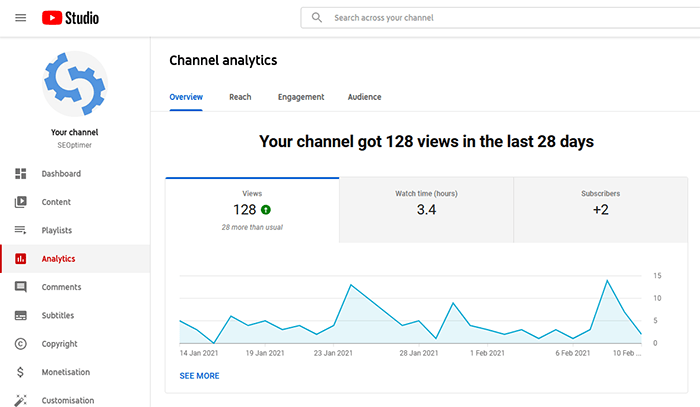
You should pay close attention to the following metrics:
Views: this is the most important YouTube metric. It refers to the total number of video views as determined by YouTube. Keep in mind, a ‘view’ is variable on YouTube. Unlike Facebook and Instagram which counts a view once someone has seen a video for at least 3-seconds. YouTube doesn’t work like this and instead counts views dynamically based on a number of criteria including video length, session details, user behavior, device and several other aspects.
Engagement: this is a group of metrics encompassing a number of very interesting aspects: such as overall watch time, average view duration on each video, the percentage of people still watching at 0:30 and video interactions such as likes, comments & shares. All these metrics shed light on how engaging the content is and whether viewers are sticking around or bouncing straight off.
Subscribers: this is a unique metric to YouTube but it’s effectively the same concept as Followers on a social channel like Instagram or Twitter. Gaining subscribers is important if your views come from YouTube itself. A channel with lots of subscribers has built-in viewership when you publish a new video. Now that YouTube is very Feed orientated, it's in your best interests to encourage viewers to subscribe so they are more likely to see future videos in the Feed.
Traffic sources: this metric breaks down where your viewers are watching your videos. The most likely places are on YouTube itself (website and app) after performing a search but there are several other places too such as the video embedded on a website, watching the video on a Smart TV or PVR or having the video be recommended in the Home or Explore tabs.
What does the YouTube Audit Tool check?
The YouTube Audit Tool performs the following checks:
Channel checks:
- Name
- Description
- Branding
- Subscribers
Video checks:
- Video Views
- Total Watch Time
- Average Watch Time Per Video
- Average Percentage of People Watching at 0:30
- Video Likes
- Video Dislikes
- Video Comments
- Video Shares
- Clicks on Description Links
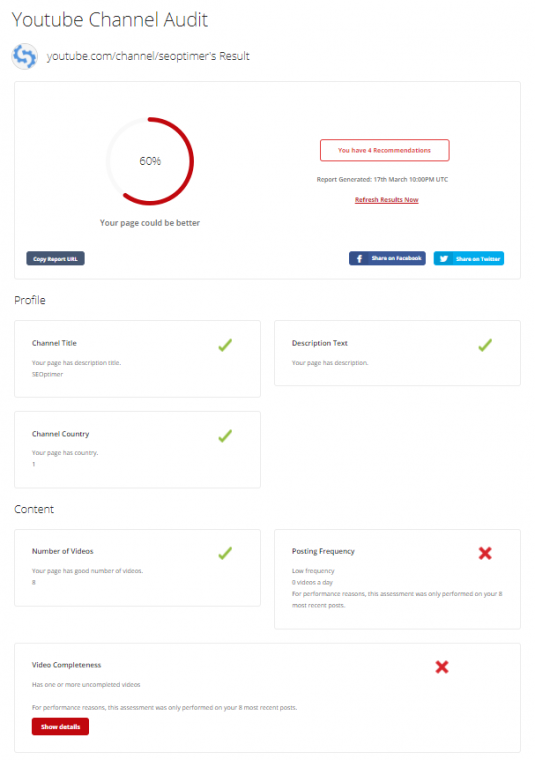
6 Tips for General YouTube Channel best practices
We recommend the following YouTube Channel best practices:
1. Complete your channel profile
This is step 1 and once you’ve this done, you can focus on optimizing your videos accordingly. Make sure you complete all the channel details fields and use relevant keywords in your channel description.
2. Focus on the first few seconds
It’s common for marketers to ask how long they should make their videos, 1-minute, 3-minutes, 10-minutes… when you look at top-performing videos, there’s no clear pattern or trend with video durations. Instead, these videos create interest and capture attention in the first few seconds. If you can hook the viewer in, it’s really irrelevant how long your video is. Don’t waste time with long introductions or establishing shots - instead focus on generating as much interest as possible in the first few seconds.
3. Master the art of video titles, descriptions and thumbnails
Video titles, video descriptions and thumbnail images are the 3 key signals used in video SEO. Although there are several others, these 3 play a big role in determining not only the ranking position but how successful they are in terms of click-through rate.
Video titles need to sell the full value of the video in a single line. This is no easy task but this line needs to be as enticing as possible. The video thumbnail is used in conjunction with the video titles by users to choose your video over other videos they see in search results. Video thumbnails that feature a person or show a key visual are best.
Video descriptions aren’t a factor for a user choosing to watch your video in search results but they play a big role in the position of your search rankings. Make sure you use long, descriptive video descriptions using all your target keywords.
4. Be single-minded
YouTube videos gain prominence in search results when they are about 1 topic or theme. This is usually because of a keyword match between the user’s search term and a combination of that keyword appearing in the video title, description, tags and/or hashtags.
5. Post at least 1 new video per week
Consistency is key on most social channels, especially YouTube. If you can cultivate habitual viewing behavior you can ride the views like a wave by releasing new videos (at least 1 per week). If users watch your previous videos, they are more likely to see your future videos in their Feed. If you can also encourage them to interact with your videos and/or subscribe to your channel, this will greatly increase your visibility.
6. Stay across trends
Keep your eye on viewer trends - especially those outside of your industry/topic. These can be great for inspiring what you do. YouTube write about the latest trends on their blog Culture & Trends and you can always see what’s currently trending from YouTube's Trending tab.